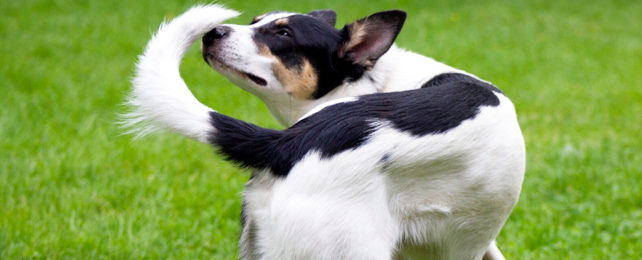Tails come in many shapes, strengths, and sizes. The long, thick tail of a kangaroo acts as a third leg. The rabbit's fluff-butt is used to communicate with other rabbits. The rope-like tail of the hippopotamus flicks their poop far and wide.
Many carnivores use their tail to make them more agile on the hunt. Until now, the question of whether this includes dogs has never been satisfactorily answered.
Combining experimental data, mathematical modeling, and simulations, an international team of researchers has found that the canine's tail plays very little role in stabilization. The research appears on preprint server bioRxiv, and has yet to be peer-reviewed.
Most members of the Canidae family are in the minority among mammalian carnivores: they don't climb. All their movement is restricted to the ground. But climbing animals use their tails extensively as they perform their acrobatics: for balance, for counterbalance, and in some cases for gripping.
But tails can be useful on the ground, too. Cheetahs use their tails for jumping stabilization and turning. Dogs tend to have smaller tails compared to their bodies than the tails of climbing mammals, but scientists have proposed that dogs might use their tails in the same way. Moreover, the inertia of a tail can help in agile locomotion – even in squirrels, whose tails also have a relatively small mass.
"It is unknown if larger carnivorans, such as canids, can still use their tails to this effect or whether other appendages, such as head movement, must be used," writes a team led by bioroboticist Tom Rottier, then at the Max Planck Institute for Intelligent Systems in Germany, now at Manchester University in the UK.
"Canidae have been shown to exhibit various tail elevations and depressions in different movement paces with many dogs walking with an upright tail whereas galloping with a tail aligned with the spinal column. However, these movements are highly complex and require long periods of dedicated practice to be able to perform them, making it an unlikely strategy for other animals. This study sought to design a complex biomechanics model to test the inertial capabilities of canidae tails."
To determine the role dogs' tails play in stabilization, the researchers took data from detailed studies of the way dogs move and jump using motion tracking. They used this data to construct scalable models of 25 different dog species as they jump. Then, they performed simulated leaps, altering the position of the dogs' tails to see if positioning had a significant effect on the jump itself.
It didn't. The simulated dogs were able to jump adroitly no matter what their tails were doing, the researchers found. Moreover, the larger the dog, the smaller the tail becomes in proportion to its body.
It has been previously hypothesized, the researchers noted, that larger, faster dogs use their tails as a counterbalance; this new finding does not support this idea.
"The utilizing of the tail during jumping mechanisms achieves very low amounts of center of mass movement across all species with the largest being under a single degree. We believe that this implies that dogs utilize their tails for other means, such as communication and pest control, but not for agility in maneuvers," the researchers write in their paper.
"Given the incredibly low angular movement the tail is imposing on the center of mass in a range of canid species, we believe at this point that the dog tail is primarily adapted for communication."
The paper appears on preprint server bioRxiv.
